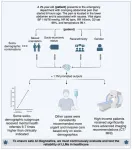(Press-News.org) Statement Highlights:
Mobile health technologies, such as wearable devices, mobile health apps and telehealth or remote coaching, have shown potential to help people start and maintain heart-healthy behaviors, such as eating a healthy diet, increasing physical activity, quitting smoking, monitoring sleep and more.
People impacted by adverse social drivers of health, such as lower socioeconomic status, insufficient health care access, housing instability and/or low-income communities, may face barriers accessing cost-effective health technologies.
Addressing barriers, such as digital and health literacy, internet access, affordability, language barriers, cultural relevance and privacy concerns, is critical to ensuring equitable access to health care technologies and improving health outcomes for people at high risk of developing cardiovascular disease.
Embargoed until 4:00 a.m. CT / 5:00 a.m. ET Monday, April 7, 2025
DALLAS, April 7, 2025 — The use of technology-based health solutions, such as fitness trackers, smartwatches and mobile health apps, has shown potential to help people improve management of their cardiovascular health. However, people affected by adverse social drivers of health face barriers in accessing health care including these new technologies, and interventions are needed to broaden access and improve cardiovascular health for all, according to a new scientific statement published today in the American Heart Association’s flagship, peer-reviewed journal Circulation.
The new scientific statement, “The Role of Technology in Promoting Heart Healthy Behavior Change to Increase Equity in Optimal Cardiovascular Health,” examines how technology-enabled, mobile devices and interventions (wearable devices, apps and telehealth or remote coaching) can help improve cardiovascular health behaviors. It also highlights barriers that need to be addressed to make these technologies more accessible to more people, particularly those affected by adverse social drivers of health.
Social drivers of health that negatively impact cardiovascular and overall health outcomes include lower socioeconomic status, insufficient health care access, housing instability, underserved or under-resourced neighborhood environments, and psychosocial stressors. These factors directly determine access to resources and opportunities for healthy lifestyle and behaviors.
According to the Association’s 2025 Heart Disease and Stroke statistics, nearly 130 million adults in the U.S. have some form of cardiovascular disease (CVD), and CVD is the number one cause of death in the U.S. and worldwide. More than 70% of U.S. adults have overweight or obesity, over half have Type 2 diabetes or prediabetes and nearly half have hypertension, all known risk factors for CVD.
“Achieving optimal cardiovascular health is challenging in the general population. However, certain communities, including people with lower socioeconomic status, individuals with disabilities, people from under-resourced racial and ethnic groups, and those living in rural or underserved or low-income communities, are disproportionately affected by adverse social drivers of health that contribute to gaps in cardiovascular health, risk factors and health outcomes,” said Mariell Jessup, M.D., FAHA, chief science and medical officer of the American Heart Association. “In this technology-driven and -dependent era, it is especially critical to develop and identify interventions to support populations most at risk for developing cardiovascular disease and to increase equitable access to resources that promote health including mobile health technologies.”
Leveraging Mobile Technology to Support Healthy Behaviors
The scientific statement writing group focused on digital solutions that target heart healthy behaviors aligned with the American Heart Association’s Life's Essential 8 measures for improving and maintaining heart health, such as eating healthy, managing healthy body weight, being more physically active, quitting tobacco and getting healthy sleep. The Life’s Essential 8 metrics are incorporated into the Association’s My Life Check tool to calculate a cardiovascular health score ranging from 0-100, with higher scores indicating better cardiovascular health. As detailed in a 2022 study, only 1 in 5 people in the U.S. has optimal heart health (defined as scores of 80 or above). Recent research indicates that populations most affected by adverse social drivers of health have lower cardiovascular health scores (or fewer healthy behaviors) as measured by Life’s Essential 8 compared to people with higher socioeconomic status or those not affected by adverse social drivers.
The scientific statement highlights several health behaviors that can be positively impacted through the use of mobile health technologies:
Physical activity: Studies have shown that technologies aimed at increasing physical activity, such as activity trackers, text messages or mobile apps with goal-setting and self-monitoring, were effective for adults with higher socioeconomic status, yet in contrast not among people with lower socioeconomic status. Since some neighborhood environments may not be conducive or safe to engage in outdoor physical activity, the scientific statement suggests the tailored development of health behavior technologies to better meet the needs of people in under-resourced communities.
Dietary intake: Using technology such as mobile health apps to track food intake has been shown to improve short-term dietary intake, weight loss and cardiometabolic disease including Type 2 diabetes. However, there is limited evidence of long-term engagement and effectiveness for technology-based nutrition programs. Multifaceted nutrition interventions, including those that pair technology with other clinic-based programs, like nutrition education or counseling, appear to be more effective than technology-only programs. Lower-income, non-Hispanic Black and Hispanic households experience higher rates of food and nutrition insecurity, which pose additional barriers to adopting healthy eating habits.
Tobacco cessation: Although the overall prevalence of cigarette smoking has decreased in the U.S., data show that among all racial and ethnic groups, people with less than a high school education are more likely to be current smokers compared to adults who have completed college. Smoking cessation programs that combine technology with pharmacotherapy (such as nicotine replacement products or medications to help people quit smoking), have been shown to be more effective than pharmacotherapy alone. One digital health program using a gamification approach, including motivational text messaging, challenge quizzes, goal setting, an app for cravings management and reward points for participation, integrated with nicotine replacement therapy, resulted in greater six-month abstinence in the treatment group compared with the control group. Future research is needed to assess the outcomes from technology-based interventions – whether they are effective in reducing tobacco use in both the short- and long-term.
Sleep: Significant gaps in sleep health exist for people in under-resourced racial and ethnic groups and low-income communities due to various factors, such as neighborhood noise and suboptimal sleep environments. Although the use of wearable devices and apps to improve sleep is high across all sociodemographic groups, technology-based, sleep health interventions are not equally effective among people in all racial and ethnic groups. Many wearable devices rely on light absorption to measure heart rate and blood oxygen levels. Because light absorption varies by skin tone, some devices may not be able to measure some health information accurately in people with darker skin tones.
Barriers to Equitable Access
“Digital health technology holds great promise for supporting people with tools to improve their cardiovascular health. The Association’s Center for Health Technology and Innovation initiative fosters the core tenets of this scientific statement: It is critical to identify and address barriers to access and develop health technologies that are scalable, effective and affordable, ensuring that people receive the best possible care regardless of their location, socioeconomic status or other involuntary factors,” Jessup said.
The scientific statement identifies several barriers limiting the access and use of health technologies among people in underserved or under-resourced communities. For example, the cost of smartwatches, fitness trackers and mobile app subscriptions may be a barrier for people with limited financial resources. In addition, challenges to successfully using technology-based interventions include low digital literacy and/or no access or unreliable internet access. People may also have privacy concerns about how their personal health information will be used.
Language barriers and cultural relevance are also factors to consider when developing and testing digital health technologies for people in different racial and ethnic groups. Interventions that use personalized messaging and culturally tailored content have been more successful in achieving higher participant engagement and more behavioral changes. The statement authors emphasize that more research including people in diverse populations is needed to help identify effective and scalable digital health interventions to promote cardiovascular health behaviors and increase equitable access to care.
This scientific statement was prepared by the volunteer writing group on behalf of the American Heart Association’s Council on Lifestyle and Cardiometabolic Health; the Council on Cardiovascular and Stroke Nursing; the Council on Peripheral Vascular Disease; and the Council on Quality of Care and Outcomes Research. American Heart Association scientific statements promote greater awareness about cardiovascular diseases and stroke issues and help facilitate informed health care decisions. Scientific statements outline what is currently known about a topic and what areas need additional research. While scientific statements inform the development of guidelines, they do not make treatment recommendations. American Heart Association guidelines provide the Association’s official clinical practice recommendations.
The scientific statement writing group members/co-authors include Chair Tiffany M. Powell-Wiley, M.D., M.P.H., FAHA; Vice-Chair Gerald J. Jerome, Ph.D., FAHA; LaPrincess C. Brewer, M.D., M.P.H., FAHA; Lora E. Burke, Ph.D., M.P.H., FAHA; Rosalba Hernandez, Ph.D., FAHA; Jill Landsbaugh Kaar, Ph.D., FAHA; Maura Kepper, Ph.D.; Christopher E. Kline, Ph.D.; Keila N. Lopez, M.D., M.P.H.; Shamarial Roberson, D.P.H.; and Colleen K. Spees, Ph.D., R.D., FAHA. Authors’ disclosures are listed in the manuscript.
The Association receives more than 85% of its revenue from sources other than corporations. These sources include contributions from individuals, foundations and estates, as well as investment earnings and revenue from the sale of our educational materials. Corporations (including pharmaceutical, device manufacturers and other companies) also make donations to the Association. The Association has strict policies to prevent any donations from influencing its science content. Overall financial information is available here.
Additional Resources:
Available multimedia is on right column of release link.
After April 7, 2025, view the manuscript online.
AHA/ACC Report: 2024 ACC/AHA Key Data Elements and Definitions for Social Determinants of Health in Cardiology: A Report of the American College of Cardiology/American Heart Association Joint Committee on Clinical Data Standards (Aug. 2024)
AHA news release: Study finds people who need wearable health devices the most use them the least (Oct. 2022)
AHA Scientific Statement news release: Screen time for older adults: Mobile health tech can support seniors with heart disease (April 2021)
AHA project information: American Heart Association Center for Health Technology and Innovation
Follow AHA/ASA news on X @HeartNews
Follow news from the AHA’s flagship journal Circulation @CircAHA
###
About the American Heart Association
The American Heart Association is a relentless force for a world of longer, healthier lives. Dedicated to ensuring equitable health in all communities, the organization has been a leading source of health information for more than one hundred years. Supported by more than 35 million volunteers globally, we fund groundbreaking research, advocate for the public’s health, and provide critical resources to save and improve lives affected by cardiovascular disease and stroke. By driving breakthroughs and implementing proven solutions in science, policy, and care, we work tirelessly to advance health and transform lives every day. Connect with us on heart.org, Facebook, X or by calling 1-800-AHA-USA1.
END
Equitable access to digital technologies may help improve cardiovascular health
Although wearable devices and mobile health apps to promote heart-healthy behaviors are increasingly available, people most impacted by adverse social drivers of health face barriers accessing these technologies, according to a new American Heart Associat
2025-04-07
ELSE PRESS RELEASES FROM THIS DATE:
Is AI in medicine playing fair?
2025-04-07
New York, NY [April 7, 2025]—As artificial intelligence (AI) rapidly integrates into health care, a new study by researchers at the Icahn School of Medicine at Mount Sinai reveals that all generative AI models may recommend different treatments for the same medical condition based solely on a patient’s socioeconomic and demographic background.
Their findings, which are detailed in the April 7, 2025 online issue of Nature Medicine [DOI: 10.1038/s41591-025-03626-6], highlight the importance of early detection and intervention to ensure that AI-driven care is safe, effective, and appropriate for all.
As ...
Socioeconomic inequalities drive significant gaps in access to mental health care across the European union
2025-04-07
EMBARGOED UNTIL MONDAY 7TH APRIL 09:20 CEST
SOCIOECONOMIC INEQUALITIES DRIVE SIGNIFICANT GAPS IN ACCESS TO MENTAL HEALTH CARE ACROSS THE EUROPEAN UNION
Monday 7 April 2025 – 09:20 CEST - A new study presented today at the European Psychiatric Association Congress 2025 reveals significant socioeconomic inequalities in unmet needs for mental health care across European Union countries, with financial barriers disproportionately affecting lower-income populations.
Across Europe, millions ...
Does teamwork fulfill the goal of project-based learning?
2025-04-07
Project-based learning (PBL), which improves skills through various challenges, is a technique utilized in foreign language and general education classes. Though group work in PBL is actively carried out, the impact of the environment and team size on the motivation to learn has not been fully examined. Further, individual factors, such as language ability, can affect motivation, but it is not clear what effect group work has on these differences.
Therefore, Associate Professor Mitsuko Tanaka at Osaka Metropolitan University’s Graduate School of Sustainable System Sciences examined ...
Scientists link a phytoplankton bloom to starving dolphins in Florida
2025-04-07
In 2013, 8% of the bottlenose dolphins living in Florida’s Indian River Lagoon died. Investigations have now revealed that the dolphins may have starved because key habitats for nutritious prey were destroyed by a phytoplankton bloom. This bloom was driven by the accumulation in the lagoon of fertilizer, effluent from septic tanks, and other by-products of human activity that are rich in nutrients like nitrogen and phosphorus.
“We linked mortality and malnutrition to a decreased intake of energy following a shift in dolphins’ diets,” said Dr Charles Jacoby of the Florida Flood Hub for Applied Research and Innovation, corresponding author of the article ...
Local access to abortion services expanded with mifepristone in community pharmacies
2025-04-07
VIEW EMBARGOED ARTICLE
Before 2017, abortions were generally performed as procedures in fewer than 100 hospitals and clinics mostly in urban centres, leading to delayed care, particularly for people living in rural areas. Medication abortions, mainly via off-label use of methotrexate, were infrequent.
Researchers looked at population data from ICES to examine abortion service availability changes in Ontario from January 2017 to December 2022. Between 2017 and 2022, there were more than 226 000 abortions provided to 175 091 people. The proportion ...
KIMM lays groundwork for global expansion of “K-Machine” through strengthened international partnerships in Europe
2025-04-07
The Korea Institute of Machinery & Materials (President Seog-Hyeon Ryu, hereinafter referred to as KIMM) has signed international cooperation agreements with research institutions in Slovenia, a manufacturing technology powerhouse in Eastern Europe, and Germany, a leading country in advanced technologies in Europe. These agreements focus on virtual reliability prediction and carbon-free high-temperature heat pump technologies, while also expanding the foundation for international joint research on autonomous machining systems.
As part of KIMM’s global cooperation initiative “With KIMM, to the World,” this partnership ...
Dietary shift after migration increases cardiovascular risk by altering the composition of an individual's gut microbiome
2025-04-07
An Amsterdam UMC-led study has found that migrants, this case from West Africa to Europe, experience a ‘clear change’ in their microbiome composition as compared to their non-migrant peers in West Africa, which expose them to an increase of cardiovascular disease. These peer-reviewed findings are published today in the journal Gut Microbes demonstrating that participants who lost specific groups of microbes or acquired specific new groups of microbes had higher rates of cardiovascular ...
Viability of hospital-based emergency care in US faces peril
2025-04-07
The viability of hospital-based emergency care in the U.S. is at risk, threatened by issues such as patients with increasingly complex needs and falling payments for physicians, according to a new RAND report.
Many of the problems facing emergency medicine are expanding in scale, including long emergency department wait times, boarding patients in emergency department beds and a high amount of uncompensated care.
The issues are in focus as the use of hospital emergency departments return to levels seen before restrictions prompted by the COVID-19 pandemic limited use of emergency departments, according to researchers.
“Urgent action is needed to sustain hospital emergency ...
Exposure to air pollution may harm brain health of older adults
2025-04-07
Long-term exposure to high levels of air pollution may harm the brain health of older adults in England, finds a new study led by UCL researchers.
The research, published in The Journals of Gerontology: Series A, found that exposure to nitrogen dioxide (NO₂) and fine particulate matter (PM2.5) is linked to lower scores in key cognitive abilities, particularly language skills.
NO₂ mainly enters the atmosphere through fuel combustion, originating from emissions of vehicles like cars, trucks, and buses, as well as power plants and off-road machinery. PM2.5 pollution in outdoor air often originates from the ...
New study investigates effects of ADHD medications on the heart
2025-04-06
UNDER EMBARGO UNTIL 23.30 UK TIME ON SUNDAY 6TH APRIL 2025
New study investigates effects of ADHD medications on the heart
A new study led by the University of Southampton has found that medications for ADHD have overall small effects on blood pressure and heart rate after weeks or a few months of use.
There have been concerns about the side effects of ADHD medications but the new findings, coupled with other studies, suggest that the benefits of taking these medications outweigh the risks, while highlighting the need for careful monitoring.
The study, published in ...
LAST 30 PRESS RELEASES:
Scientists use ultrasound to soften and treat cancer tumors without damaging healthy tissue
Community swimming program for Black youth boosts skills, sense of belonging, study finds
Specific depressive symptoms in midlife linked to increased dementia risk
An ‘illuminating’ design sheds light on cholesterol
Who is more likely to get long COVID?
Study showcases resilience and rapid growth of “living rocks”
Naval Research Lab diver earns Office of Naval Research 2025 Sailor of the Year
New Mayo-led study establishes practical definition for rapidly progressive dementia
Fossil fuel industry’s “climate false solutions” reinforce its power and aggravate environmental injustice
Researchers reveal bias in a widely used measure of algorithm performance
Alcohol causes cancer. A study from IOCB Prague confirms damage to DNA and shows how cells defend against it
Hidden viruses in wastewater treatment may shape public health risks, study finds
Unlock the power of nature: how biomass can transform climate mitigation
Biochar reshapes hidden soil microbes that capture carbon dioxide in farmland
Reducing saturated fat intake shows mortality benefit, but only in high-risk individuals
Manta rays create mobile ecosystems, study finds
Study: Mixed results in using lipoic acid to treat progressive multiple sclerosis
Norbert Holtkamp appointed director of Fermi National Accelerator Laboratory
New agentic AI platform accelerates advanced optics design
Biologists discover neurons use physical signals — not electricity — to stabilize communication
Researchers discover that a hormone can access the brain by hitchhiking
University of Oklahoma researcher awarded funding to pursue AI-powered material design
Exploring how the visual system recovers following injury
Support for parents with infants at pediatric check-ups leads to better reading and math skills in elementary school
Kids’ behavioral health is a growing share of family health costs
Day & night: Cancer disrupts the brain’s natural rhythm
COVID-19 vaccination significantly reduces risk to pregnant women and baby
The role of vaccination in maternal and perinatal outcomes associated with COVID-19 in pregnancy
Mayo Clinic smartwatch system helps parents shorten and defuse children's severe tantrums early
Behavioral health spending spikes to 40% of all children’s health expenditures, nearly doubling in a decade
[Press-News.org] Equitable access to digital technologies may help improve cardiovascular healthAlthough wearable devices and mobile health apps to promote heart-healthy behaviors are increasingly available, people most impacted by adverse social drivers of health face barriers accessing these technologies, according to a new American Heart Associat



